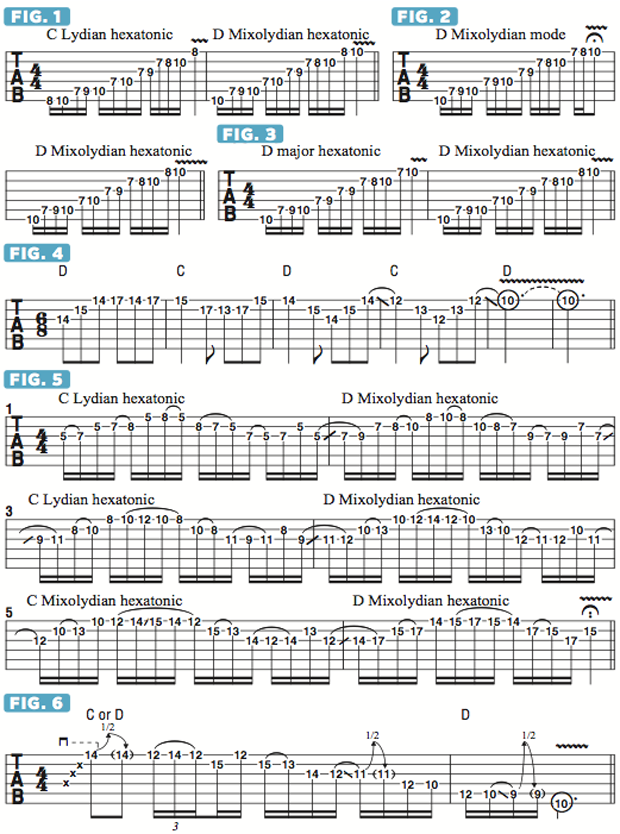Fun with Two Bright-Sounding, Uniquely Flavored Scales Built from the Same Six Notes
Last month, I presented the intriguingly exotic C Lydian hexatonic scale, which is formed by combining C and D triads (C E G + D F# A = C D E F# G A). Now, as we had done with E minor and D major hexatonic in the preceding lesson, I’d like to reveal the flip side of the musical coin and introduce an appealing mode of C Lydian hexatonic, D Mixolydian hexatonic, which has a bright and playful quality and is comprised of the very same six notes, only reoriented around a D root—D E F# G A C (see FIGURE 1).
As I will demonstrate, this modal relationship between the two scales is very convenient and useful for crafting sweet-sounding melodies over a C-to-D or D-to-C chord vamp. But first, some more helpful insight into D Mixolydian hexatonic. Another way to think of this scale is to take the seven-note D Mixolydian mode (D E F# G A B C) and omit the sixth, B, which creates a wide, minor-pentatonic-like gap—a minor third interval, between the fifth, A and the minor, or “flat” seventh, C (see FIGURE 2).
As I pointed out with C Lydian hexatonic versus the full C Lydian mode last month, D Mixolydian hexatonic retains the signature notes of D Mixolydian, in this case the minor seventh, C, and the major third, F#, in a way that sounds slightly less dense and more “open” and arpeggio-like, while offering more useful rhythmic phrasing options, due to the lesser and even number of notes (six instead of seven).

You could also think of D Mixolydian hexatonic as being nearly identical to D major hexatonic (D E F# G A B), the only difference being the inclusion of the minor seventh, C, instead of the sixth, B, which subtly changes the scale’s character and flavor (see FIGURE 3). To me, this distinction makes D Mixolydian hexatonic sound more “Celtic” than “country.” Speaking of which, FIGURE 4 is a sprightly, Irish fiddle–style melody in 6/8 meter that’s based on alternating D and C major arpeggios and makes me think of leprechauns.
FIGURE 5 is a slippery legato run played across the top three strings that alternates between C Lydian hexatonic and D Mixolydian hexatonic and ascends the fretboard through higher “inversions” of each scale, using finger slides to shift positions and create a seamless flow of notes. Try applying this same type of pattern to other string groups.
Inspired by Jeff Beck, Joe Satriani and Warren Haynes, FIGURE 6 is a tumbling lead phrase that descends the fretboard diagonally and exploits a quick, decorative half-step bend and release from F# to G in three different octaves to create a noodle-y, sitar-like effect.
All the latest guitar news, interviews, lessons, reviews, deals and more, direct to your inbox!
Over the past 30 years, Jimmy Brown has built a reputation as one of the world's finest music educators, through his work as a transcriber and Senior Music Editor for Guitar World magazine and Lessons Editor for its sister publication, Guitar Player. In addition to these roles, Jimmy is also a busy working musician, performing regularly in the greater New York City area. Jimmy earned a Bachelor of Music degree in Jazz Studies and Performance and Music Management from William Paterson University in 1989. He is also an experienced private guitar teacher and an accomplished writer.

